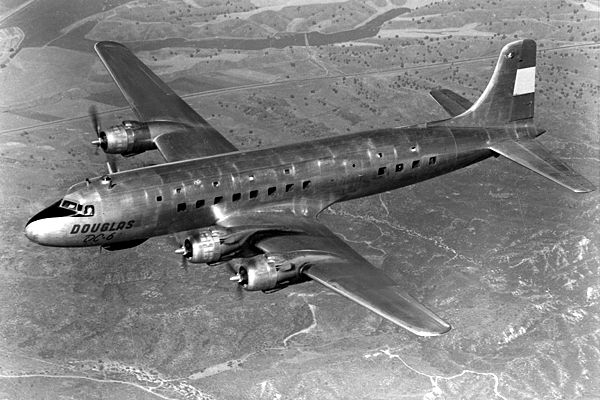|
Douglas DC 6

The
fact that the competition was introducing cabin pressurisation (Boeing
Stratoliner and Lockheed Constellation) made Douglas decide that the
improved version over the C-54 (DC-4) needed that too. It would enable to
maintain higher altitudes and fly "over the weather". Of course, as a
result other improvements had to be faced too: improved de-icing system,
more power from the engines, better radio- and navigational equipment, etc
Ground work was laid during W.W.2 and the first test flight was made in
February 1946. This was the military XC-112A prototype.

Douglas used the same wing as with the DC-4 and the fuselage was
lengthened by 2.06 metres (6 ft. 9 in.).
Initially Douglas had a military order in mind, but the end of the war
brought a change of direction towards commercial use. One of the things
they had to keep in mind, was of course the distribution of weights. There
were high loads of cargo of sorts, but with fashionable ladies on board,
they had to keep in mind the weight of a woman concentrated in the
pressure of her high-heel, without damage. The difference in use with the
military and civilian operators, if there ever was one at that time !
Both American Airlines and United Airlines received their first deliveries
in 1947. Companies like National Airlines, Braniff and Delta followed
quickly. The competition was Eastern and TWA with their Constellations.
Unfortunately, only months after the first initial deliveries, all DC-6s
were grounded as a result of the crash of a DC-6, operated by United
Airlines, at Bryce Canyon and an in-flight fire onboard an American A/l
DC-6.. After investigation into these mishaps, all aircraft were
subsequently modified and were back in service during march 1948.
The US Air Force took delivery of one (no.26th of the production line),
designated it C-118, and this one became the presidential aircraft
("Independence")
After confidence was restored in the DC-6, Delta and European customers
(Sabena, KLM, SAS) put in orders in 1948. So did Philippine Air Lines,
which started using the DC-6 in 1948 on routes from of Manilla to London
and San Francisco .
Many companies followed and when the last order was counted in 1950, it
totalled 175.
Then Douglas came with the improved DC-6A and -B models.

Many
operators used their Sixes on long-haul routes. In most cases they were
replaced in the late 1950s or early 1960s. Some had airframe hours
totalling around 50.000 - 55.000 and were scrapped. Others moved down the
line, selling (in the 1960s) for aprox. $500,000.
In 2000 there is but one DC-6 still operational, serving as an air tanker,
fighting forest fires. This is N90739 (cn43044/84) and it operates for TBM
in the USA.
The DC-6A is a freighter-version with improved Pratt & Whitney R2800-CB17
radial engines, with water-methanol injection. With all this extra power,
the DC-6 fuselage was lengthened by 5 ft. It was nicknamed "the Liftmaster"
and was meant to transport cargo. The DC-6A kept its cabin pressurisation,
had a reinforced cabin floor to take the weight of the cargo, it had no
windows in the fuselage and it featured cargo doors both forward of the
wing, as well as aft. Fuel capacity was increased, too. The electrical
system was improved over the DC-6, which had been comparatively poor. The
DC-6A was meant to suit both military- as well as civil operators.
Slick Airways in the USA was the first civil operator (April 1954).
American Airlines, Japan A/l, Flying Tigers, Sabena, KLM followed quickly
as customers.
A total of 74 DC-6As were produced.
Some DC-6As were later converted to passenger use, by removing the metal
plugs fitted over the cabin windows. Others were built with normal cabin
windows to enable rapid change from cargo- to passenger configuration and
vice versa. These were designated DC-6C.
The US Navy took delivery of 65 examples, designating them R6D-1. The US
Navy redesignated them C-118B in 1962.
The US Air Force accepted 101 C-118As.
The DC-6B is the passenger version, with many of the specifications of the
DC-6A in terms of performance and dimensions, but without the reinforced
floor and main deck cargo doors. At first, it seated 54 passengers but
later it was configured, in high density, to as much as 102 passengers.
The first production model of the DC-6B went to United Airlines in 1951
and served United until 1968. The 288th and last DC-6B to be produced was
delivered to JAT Jugoslovenski Aerotransport in 1958.
Production of the DC-6B ended in 1958, by which time 288 had been built.
Many DC-6As and -Bs were later reconfigured for non-scheduled operators to
convertible passenger-cargo configurations. Later in aviation history we
see many types, like the DC-9-33 and B737, produced by the factory to
"Rapid Change" or "Quick Change" versions, borrowing on the idea of
transporting passengers during the day and cargo during the night. A small
number of DC-6As were reconfigured thus by Douglas prior to delivery and
they received the designation DC-6C; others, the ones reconfigured later,
were referred to as DC-6A/B.
Two DC-6Bs were converted to "swing-tails" (DC-6B-ST). This was done by
the engineering shop of SABENA. The Douglas DC-6B was the supreme
piston-engined airliner. Its success was brought on by its low operating
costs. When the first orders were placed, in 1949, it cost $900,000.
A grand total of 704 Sixes have been produced.
Engines: 4 Pratt & Whitney R2800
Double Wasp Radials
Max.speed 645 km/h
Cruising speed: 507 km/h
Ceiling: 7.620 m.
Range: 4.836 km with max payload
Weight empty: 25.110 kgs
Weight loaded: 48.534 kgs
Dimensions: span 35,81m - length 32,18m - height 8,74m
|
